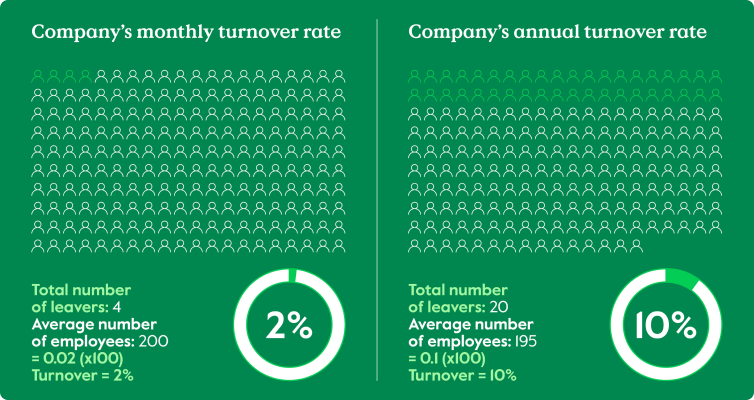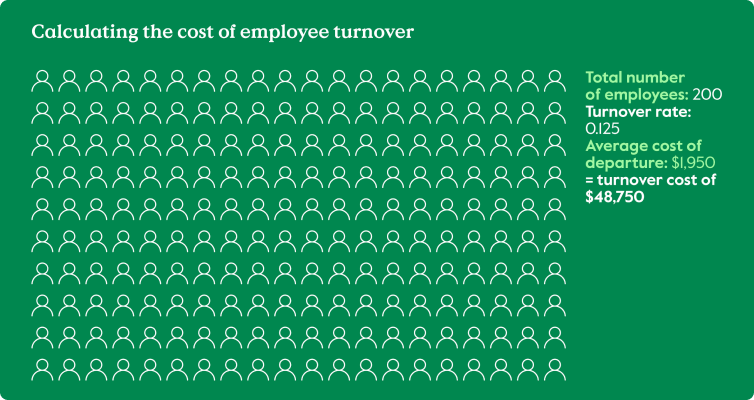What is employee turnover?
Employee turnover refers to the number of employees who leave a company and need to be replaced by new hires. This can be voluntary, where an employee chooses to leave for another job, or involuntary, through redundancy or termination. Tracking and analysing the employee retention rate is essential for HR professionals; understanding the reasons why employees are leaving is necessary and saves against the cost of recruitment, and to retain high-quality employees.
Why is employee turnover important?
Employee turnover is important to your business because of the associated costs, both direct and indirect. Directly, the cost of terminating employment, posting the job vacancy and recruitment of new staff are all significant in themselves, not to mention the impact that turnover has on productivity. High turnover always costs companies money and can become a perpetual spiral if the core issues are not resolved.
However, indirectly, the costs of high turnover don’t stop there. Not only is it financially damaging, but it can affect company culture too. Staff turnover can point to underlying issues, perhaps with management practices or environmental issues, harming morale and engagement.

What contributes to the cost of turnover?
Separation costs
Separation costs refers to various expenses related to the termination of employment, such as exit interviews and administrative tasks. There is the associated cost of time on paperwork and documentation when employees leave an organisation as well as the cost of any legal fees and severance packages that may be involved in the process. Also, exit interviews play a crucial role in understanding the reasons for employee departure and can provide valuable feedback. There is a balancing act to be struck between cutting costs and investigating employee turnover.
Vacancy costs
Vacancy costs arise when a position remains unfilled, leading to a loss of productivity. The longer a position remains vacant, the more it impacts productivity and workload distribution, and the more it costs, for example with recruitment agency fees for temporary staff cover.
For specialist roles that require specific skills, these costs can be particularly high. To combat vacancy costs, efficient recruitment and onboarding processes are essential. By finding the right employees in a timely manner, organisations minimise the negative impact of vacancies and ensure a smoother workflow.
Replacement costs
The cost of replacing an employee incurs a range of expenses for businesses: the cost of advertising job vacancies, conducting interviews, performing background and reference checks and onboarding the new staff member.
Additionally, training costs for new hires can be substantial, especially for roles that require specialised skills. Trying to find and attract the right candidates as efficiently as possible requires investment and streamlining of the recruitment process.
While there is a cost implication in the short term, it will pay off by a minimising turnover if employees who fit the company's values and have the right skills to succeed can be recruited.
Training costs
When new hires join a company, they require time and resources to get up to speed. The complexity of the job can influence the training costs. Effective onboarding programmes can help reduce these expenses and accelerate employee productivity.
Also, investing in ongoing training and development can reduce staff turnover while improving performance. By providing employees with the right skills and knowledge, companies can minimise the need for extensive training, ultimately saving costs in the long run.
How to calculate employee turnover
Calculating employee turnover rates is done by measuring how many employees leave a company in a given period, usually per month or year. By dividing the total number of leavers in a month by your average number of employees in a month, then multiplying by 100, you will be left with your turnover rate.
How do you calculate the monthly average employees? By taking the number at the start of the month and adding to the number at the end of the month, then dividing by two.
Take a look at the graphic below, where we calculate a company’s monthly and annual turnover rate.

The monthly rate will help you recognise the times of the year that your company is particularly susceptible to turnover. This is useful, but only to an extent. If you wanted a longer-term view, you’ll need to do the same calculation by year.
If you want to be more precise, you could choose to track voluntary turnover and involuntary turnover separately.
Turnover will vary per sector, but it’s worthwhile knowing the industry average turnover rate for your business.
Calculating the cost of employee turnover
When calculating the cost of employee turnover, consider both direct costs, such as separation, replacement, and training expenses, and indirect costs, including lost productivity and lower morale. Only by understanding these costs can organisations implement the correct strategies to reduce staff turnover rates and reap the benefits of low employee turnover.
Calculating the cost of employee turnover is a more complicated equation, but has some key steps:
- Period of measurement - month, quarter, or year
- Calculate turnover rate
- Work out the average cost of departure – this includes all the direct and indirect costs. Once this is done, you can divide total expenses by the number of departures and determine the average cost of one separation
- Calculate turnover cost – The formula is: total number of staffers x turnover rate x average cost of departure

Factors determining your company turnover rate
Salaries and benefits
- Salaries that are competitive and incentivise hard work are more likely to retain employees. Raises in line with cost-of-living will help improve employee retention rate.
Company culture
- Strong organisational values are key to a functioning business. If a company talks about good mental health practice but doesn’t provide adequate time off, this will not encourage people to stay.
- Overworked employees will not feel valued, and can experience burnout, mental fatigue, and reduced productivity. Long working hours, poor work-life balance and excess responsibilities are just some reasons why an employee might look for a new job with a healthier balance.
Lack of career growth
- When team members stay in one role for a long period of time without moving up, they may feel undervalued and underutilised.
- Most employees want to learn new or advanced skills, earn professional certifications, or complete role-specific training. If this is not available, organisations risk team members stagnating in their improvement or losing them to a company that does provide these opportunities.
Leadership
- Inconsistent management styles, poor communication, and teams feeling unsupported are a recipe for employees feeling undervalued, unimportant, and ready to move elsewhere.
Employee turnover burdens your business with both direct and indirect costs, so being able to track the reasons why employees are leaving and mitigate against them is essential to a functioning business environment and to save money. By recognising the factors encouraging employees to leave, such as poor mental or financial health, companies can introduce strategies that help employees. In this way, employees are happier, healthier, and your business grows.

